Narra Tree
- December 5, 2023
- 0 comment
The Narra tree, scientifically known as Pterocarpus indicus, stands as an iconic and culturally significant species in various parts of Southeast Asia, particularly in the Philippines, where it holds the esteemed title of the national tree. Revered for its majestic stature and distinctively durable hardwood, the Narra tree has played a pivotal role in the region’s history and culture.


With its vibrant and lustrous golden-brown timber, Narra is highly sought after for furniture, flooring, and intricate woodcraft. Beyond its practical uses, the tree carries symbolic weight, embodying strength, endurance, and resilience. Additionally, its blossoms, displaying a riot of yellow and orange hues, add to the tree’s aesthetic appeal.
The Narra tree’s significance extends into folklore and traditional medicine, further solidifying its place in the hearts and minds of the communities it graces. As a testament to its enduring legacy, the Narra tree stands not only as a botanical marvel but as a living emblem of cultural heritage and natural splendor.
| Characteristic | Description |
|---|---|
| Scientific Name | Pterocarpus indicus |
| Common Name | Narra |
| National Tree of | Philippines |
| Wood Color | Golden-brown |
| Wood Characteristics | Durable hardwood |
| Uses | Furniture, flooring, woodcraft |
| Symbolism | Strength, endurance, resilience |
| Flower Color | Yellow and orange |
| Cultural Significance | Folklore, traditional medicine |
| Geographical Range | Southeast Asia, particularly Philippines |
| Aesthetic Appeal | Majestic stature, vibrant blossoms |
| Conservation Status | Generally not threatened, but regional variations may exist |
| Importance | Emblem of cultural heritage and natural beauty |
Botanical Beauty of Narra Tree

The Narra tree (Pterocarpus indicus) stands as a botanical marvel, captivating observers with its majestic stature and striking features. This hardwood giant, native to Southeast Asia and notably the Philippines, boasts an elegant display of golden-brown timber that has become synonymous with both cultural heritage and natural beauty. Its botanical allure extends beyond its practical uses, making the Narra tree a living testament to the splendor found in the world of flora.
Woodland Elegance
Renowned for its durable hardwood, the Narra tree is a symbol of woodland elegance. The timber harvested from this majestic tree graces homes and spaces with furniture and flooring of unparalleled quality. The distinctive golden-brown hue of Narra wood adds warmth and sophistication to any environment, making it a preferred choice for those who appreciate both functionality and aesthetic appeal in their surroundings.

Ecological Importance

Beyond its visual grandeur and practical applications, the Narra tree plays a vital role in the ecosystem. Its extensive root system aids in soil stability and erosion prevention. As a part of the intricate web of biodiversity, the Narra tree contributes to the overall health of its habitat, providing shelter and sustenance for various flora and fauna. Understanding the ecological importance of this species sheds light on the interconnectedness of nature and the role each tree plays in maintaining balance.
Cultivation and Conservation
Cultivating and conserving the Narra tree is essential for preserving its cultural significance and ecological contributions. Efforts to sustainably manage Narra populations ensure that future generations can continue to benefit from its many attributes. Conservation initiatives also recognize the need to protect the habitats where Narra trees thrive, promoting biodiversity and safeguarding the delicate ecosystems they inhabit.
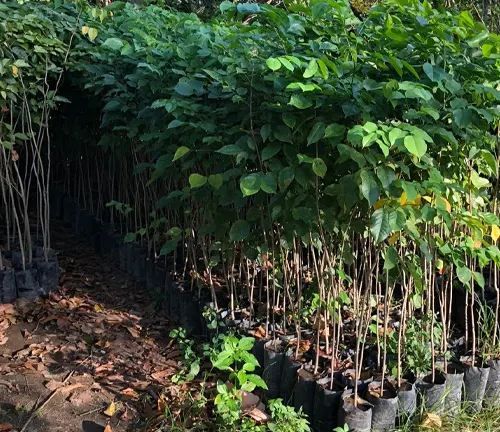
Fragrance
In addition to its visual and ecological appeal, the Narra tree delights the senses with its fragrant blossoms. The tree produces clusters of flowers characterized by vibrant yellow and orange hues. The sweet and subtle fragrance of these blooms adds an olfactory dimension to the overall experience of encountering the Narra tree, creating a multisensory connection with nature.
Soil Stabilization
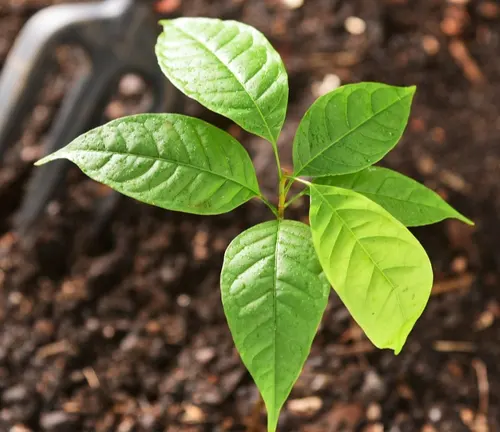
One of the unsung heroes of the Narra tree lies beneath the ground – its roots. The extensive root system not only provides stability to the tree itself but also plays a crucial role in preventing soil erosion. This feature makes the Narra tree a valuable asset in regions prone to environmental challenges, showcasing its resilience and contribution to sustainable land management.
Common Uses
The versatility of Narra wood extends its influence into various aspects of daily life. Apart from furniture and flooring, Narra wood is a popular choice for intricate woodcraft, showcasing the skillful artistry that can be achieved with its durable and workable material. The widespread application of Narra wood underscores its cultural and economic significance in the regions where it thrives.
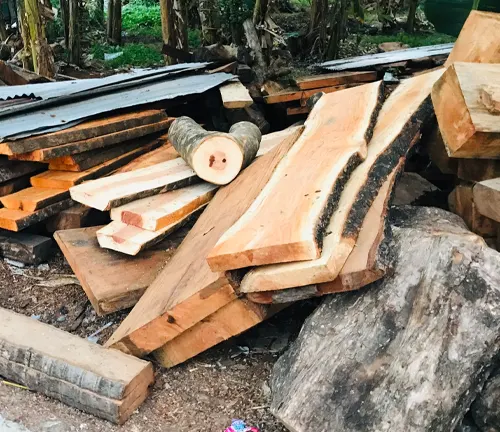
Benefits
Embracing the Narra tree goes beyond its tangible uses; it encompasses a range of benefits that touch the realms of culture, environment, and well-being. From providing livelihoods through the woodworking industry to enhancing the beauty of landscapes, the Narra tree stands as a testament to the harmonious relationship between humans and nature. Recognizing and appreciating the myriad benefits of the Narra tree is key to ensuring its continued presence and impact on the world around us.
Different Species
Pterocarpus indicus
Commonly known as Narra, this species is native to Southeast Asia and is the national tree of the Philippines. It is prized for its golden-brown hardwood.
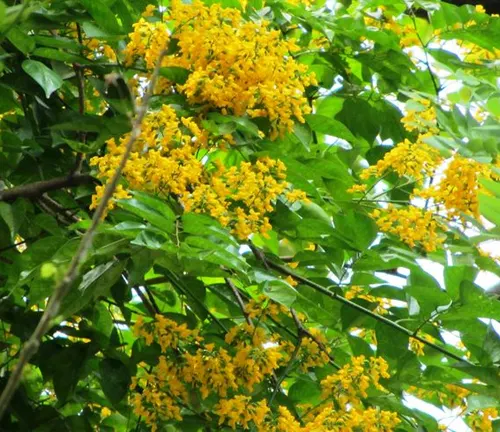
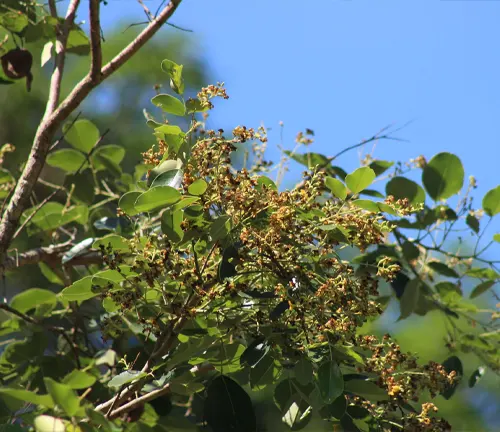
Pterocarpus santalinus
Also known as Red Sanders or Red Sandalwood, this species is native to India. It is famous for its dark red wood, which is used in traditional medicine, woodworking, and religious rituals.
Pterocarpus macrocarpus
Found in Southeast Asia, this species is commonly known as Burma Padauk. It features a distinctive orange to red-brown wood and is used for furniture, carvings, and construction.
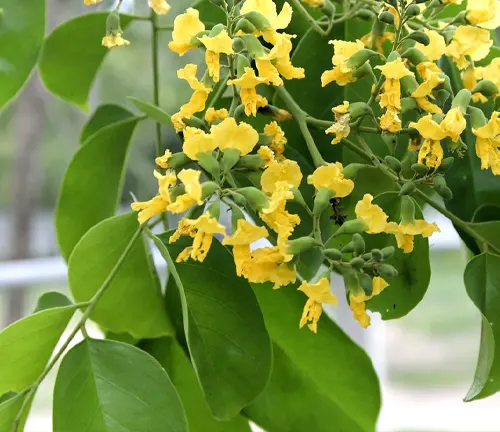
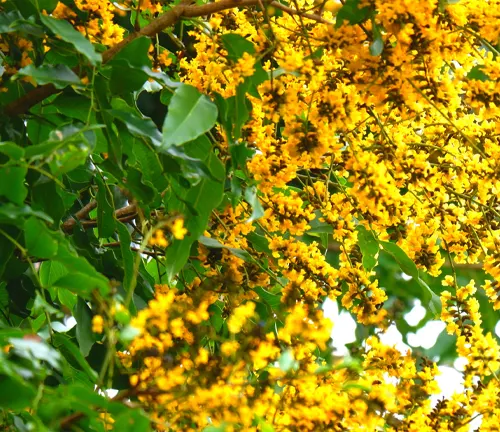
Pterocarpus marsupium
Known as Indian Kino Tree, this species is native to India. It has medicinal properties and is used in traditional medicine. The wood is also employed for various purposes.
Frequently Asked Questions (FAQs)
- What is the Narra tree?
The Narra tree, scientifically known as Pterocarpus indicus, is a species of hardwood tree native to Southeast Asia, particularly the Philippines. It is renowned for its golden-brown timber and holds cultural significance. - Why is the Narra tree important?
The Narra tree is important for various reasons, including its cultural significance, ecological contributions, and the high-quality hardwood it produces. It is the national tree of the Philippines. - What does Narra wood look like?
Narra wood is characterized by its distinct golden-brown color. It has a lustrous and vibrant appearance, making it highly desirable for furniture, flooring, and decorative woodcraft. - What is the ecological importance of the Narra tree?
The Narra tree plays a vital role in ecosystems by contributing to soil stabilization, preventing erosion, and providing habitat for diverse flora and fauna. - How is the Narra tree cultivated?
The cultivation of Narra trees involves proper soil and climate conditions. Sustainable practices are essential to ensure the continued availability of Narra wood without harming the environment. - Is the Narra tree endangered?
While the Narra tree is not generally considered endangered, regional variations may exist. Conservation efforts are crucial to maintain healthy populations and preserve the tree’s cultural and ecological significance. - What are the common uses of Narra wood?
Narra wood is used for furniture, flooring, and intricate woodcraft. Its versatility, durability, and aesthetic appeal make it a preferred choice in woodworking. - Are there different species of Narra trees?
The term “Narra tree” is often used to refer specifically to Pterocarpus indicus. However, there are other species within the Pterocarpus genus, such as Pterocarpus santalinus and Pterocarpus macrocarpus, each with its own characteristics. - Does the Narra tree have any cultural significance?
Yes, the Narra tree holds cultural significance, particularly in the Philippines, where it is the national tree. It is often associated with strength, endurance, and resilience in local folklore. - What are the benefits of the Narra tree?
The Narra tree provides a range of benefits, including economic value through the woodworking industry, environmental contributions such as soil stabilization, and cultural significance in various traditions and practices.







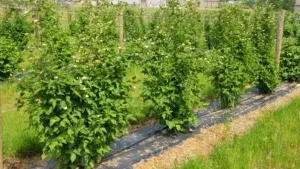

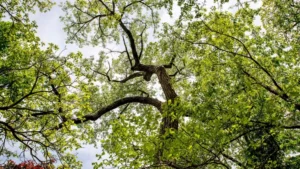



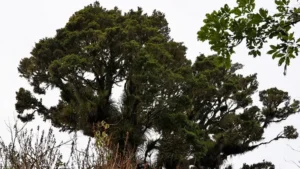
Leave your comment